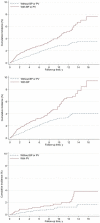Risk of Incident Venous Thromboembolism Among Patients With Bullous Pemphigoid or Pemphigus Vulgaris: A Nationwide Cohort Study With Meta-Analysis
- PMID: 37642024
- PMCID: PMC10547313
- DOI: 10.1161/JAHA.123.029740
Risk of Incident Venous Thromboembolism Among Patients With Bullous Pemphigoid or Pemphigus Vulgaris: A Nationwide Cohort Study With Meta-Analysis
Abstract
Background Bullous pemphigoid (BP) and pemphigus vulgaris (PV) share similar pathophysiology with venous thromboembolism (VTE) involving platelet activation, immune dysregulation, and systemic inflammation. Nevertheless, their associations have not been well established. Methods and Results To examine the risk of incident VTE among patients with BP or PV, we performed a nationwide cohort study using Taiwan's National Health Insurance Research Database and enrolled 12 162 adults with BP or PV and 12 162 controls. A Cox regression model considering stabilized inverse probability weighting was used to calculate the hazard ratios (HRs) for incident VTE associated with BP or PV. To consolidate the findings, a meta-analysis that incorporated results from the present cohort study with previous literature was also conducted. Compared with controls, patients with BP or PV had an increased risk for incident VTE (HR, 1.87 [95% CI, 1.55-2.26]; P<0.001). The incidence of VTE was 6.47 and 2.20 per 1000 person-years in the BP and PV cohorts, respectively. The risk for incident VTE significantly increased among patients with BP (HR, 1.85 [95% CI, 1.52-2.24]; P<0.001) and PV (HR, 1.99 [95% CI, 1.02-3.91]; P=0.04). In the meta-analysis of 8 studies including ours, BP and PV were associated with an increased risk for incident VTE (pooled relative risk, 2.17 [95% CI, 1.82-2.62]; P<0.001). Conclusions BP and PV are associated with an increased risk for VTE. Preventive approaches and cardiovascular evaluation should be considered particularly for patients with BP or PV with concomitant risk factors such as hospitalization or immobilization.
Keywords: bullous pemphigoid; cohort study; meta‐analysis; pemphigus vulgaris; systematic review; venous thromboembolism.
Figures


Comment in
-
Beyond the Surface: Investigating the Relationship Between Autoimmune Blistering Disorders and Venous Thromboembolism.J Am Heart Assoc. 2023 Sep 5;12(17):e031086. doi: 10.1161/JAHA.123.031086. Epub 2023 Aug 29. J Am Heart Assoc. 2023. PMID: 37642021 Free PMC article. No abstract available.
Similar articles
-
Increased risk of venous thromboembolism in patients with bullous pemphigoid. The INVENTEP (INcidence of VENous ThromboEmbolism in bullous Pemphigoid) study.Thromb Haemost. 2016 Jan;115(1):193-9. doi: 10.1160/TH15-04-0309. Epub 2015 Aug 6. Thromb Haemost. 2016. PMID: 26245987
-
Association between bullous pemphigoid and risk of venous thromboembolism: A nationwide population-based cohort study.J Dermatol. 2022 Aug;49(8):753-761. doi: 10.1111/1346-8138.16412. Epub 2022 May 2. J Dermatol. 2022. PMID: 35491650
-
Risk of bullous pemphigoid and pemphigus in patients on chronic dialysis: A nationwide population-based cohort study.J Dermatol. 2023 Dec;50(12):1568-1575. doi: 10.1111/1346-8138.16948. Epub 2023 Sep 4. J Dermatol. 2023. PMID: 37665203
-
Worldwide epidemiologic factors in pemphigus vulgaris and bullous pemphigoid.Front Immunol. 2023 Apr 25;14:1159351. doi: 10.3389/fimmu.2023.1159351. eCollection 2023. Front Immunol. 2023. PMID: 37180132 Free PMC article. Review.
-
Association of Psoriasis With Incident Venous Thromboembolism and Peripheral Vascular Disease: A Systematic Review and Meta-analysis.JAMA Dermatol. 2022 Jan 1;158(1):59-67. doi: 10.1001/jamadermatol.2021.4918. JAMA Dermatol. 2022. PMID: 34851364 Free PMC article.
Cited by
-
Laboratory and clinical haemostatic aberrations in primary dermatologic disease: A review.Thromb J. 2024 Nov 12;22(1):101. doi: 10.1186/s12959-024-00665-w. Thromb J. 2024. PMID: 39533305 Free PMC article. Review.
-
JAK-STAT pathway, type I/II cytokines, and new potential therapeutic strategy for autoimmune bullous diseases: update on pemphigus vulgaris and bullous pemphigoid.Front Immunol. 2025 Apr 8;16:1563286. doi: 10.3389/fimmu.2025.1563286. eCollection 2025. Front Immunol. 2025. PMID: 40264772 Free PMC article. Review.
-
IgG autoantibodies in bullous pemphigoid induce a pathogenic MyD88-dependent pro-inflammatory response in keratinocytes.Nat Commun. 2025 Aug 6;16(1):7254. doi: 10.1038/s41467-025-62495-2. Nat Commun. 2025. PMID: 40769980 Free PMC article.
-
Beyond the Surface: Investigating the Relationship Between Autoimmune Blistering Disorders and Venous Thromboembolism.J Am Heart Assoc. 2023 Sep 5;12(17):e031086. doi: 10.1161/JAHA.123.031086. Epub 2023 Aug 29. J Am Heart Assoc. 2023. PMID: 37642021 Free PMC article. No abstract available.
References
-
- Wu CY, Wu CY, Lin YH, Chang YT. Statins did not reduce the mortality risk in patients with bullous pemphigoid: a population‐based cohort study. Dermatol Sin. 2021;39:153–154. doi: 10.4103/ds.ds_14_21 - DOI
Publication types
MeSH terms
LinkOut - more resources
Full Text Sources
Medical

